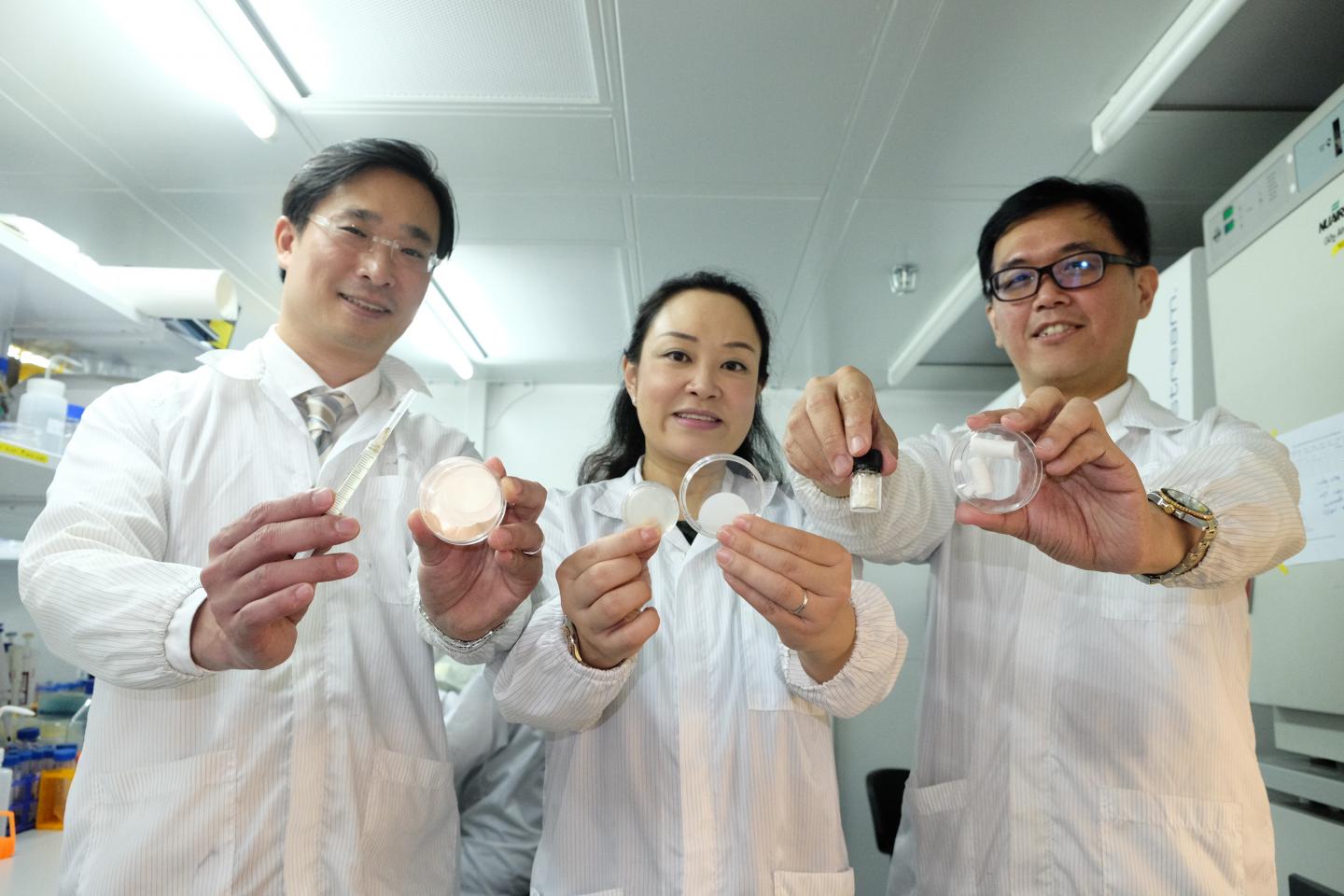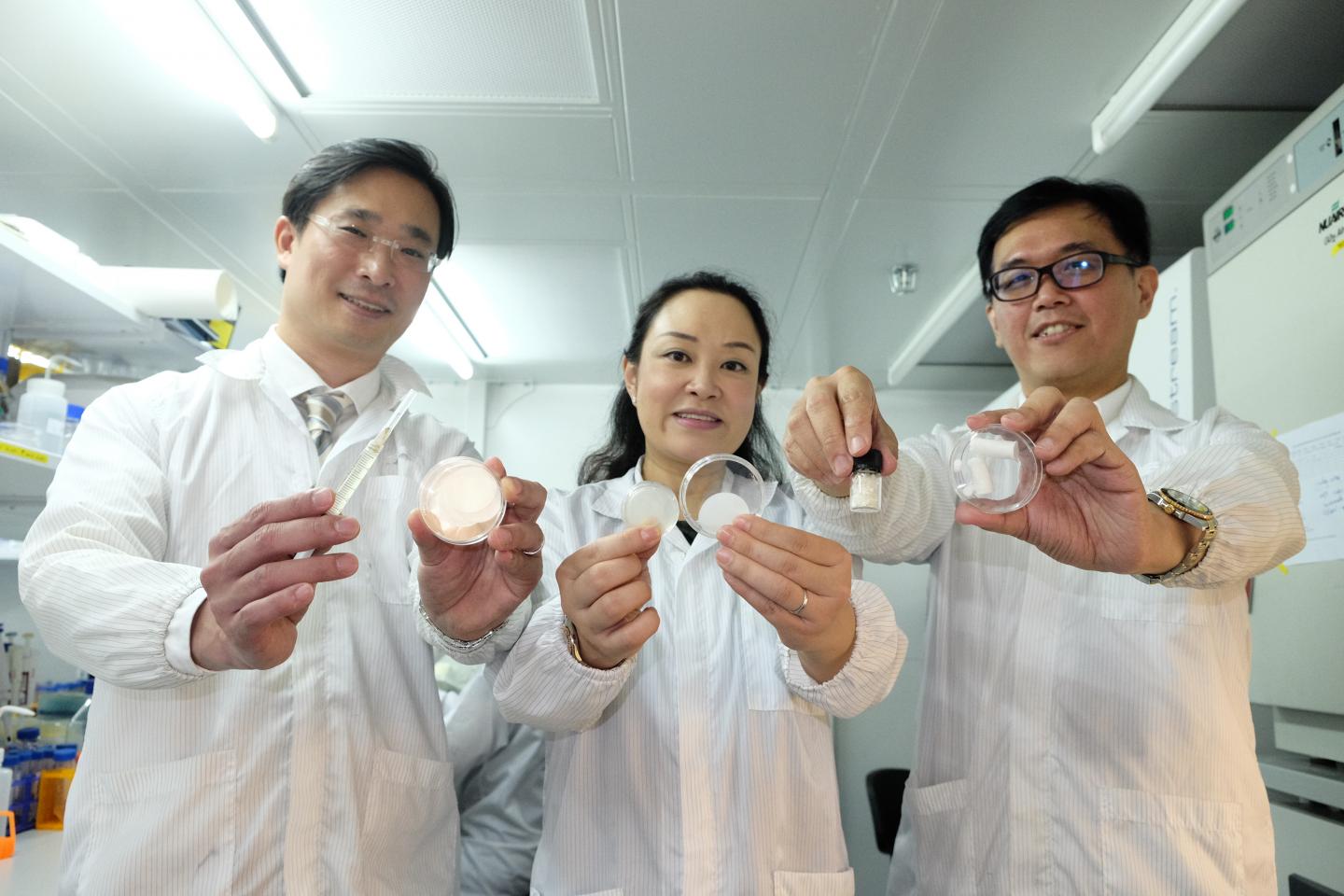
Credit: NTU Singapore
Scientists from Nanyang Technological University, Singapore (NTU Singapore) have developed a new gel patch prototype that could speed up the healing of a skin wound while minimising the formation of scars. The team unveiled the patch today as a proof-of-concept.
When fully developed, this healing patch could be a boon for diabetic patients, who suffer from hard-to-heal skin lesions and for patients undergoing surgery.
The new patch is unlike other single-purpose patches in the market, which either reduce the scarring or improve healing, but not both.
The NTU research team led jointly by Associate Professor Andrew Tan and Assistant Professor Cleo Choong, recently published their findings in Scientific Reports, a peer-reviewed journal under the Nature Publishing Group.
In the published paper, the team found that a protein known as Angiopoietin-like 4 (ANGPTL4) reduces inflammation in the early phase of wound healing in mice models. Later, it helps in the formation of new blood vessels and cell growth, and at the final phase, reduces scarring.
The team developed their patch enriched with ANGPTL4 to control the amount of scarring. NTU already has a patent on the use of Angiopoietin-like 4 (ANGPTL4) in wound healing, which can be licensed to pharmaceutical companies.
Assoc Prof Andrew Tan, the corresponding author of the paper, said scarring happens when excessive collagen produced by the body is assembled in one direction.
"To reduce scars, all we had to do was to find a 'tuning knob' that controls the amount of collagen produced, instead of turning it off completely which is what typical anti-scarring medicine does, and which could interfere with the healing process," explained Assoc Prof Tan from NTU's School of Biological Sciences.
In their experiments involving mice with diabetic wounds, a wound was shown to heal stronger and thrice as fast with the application of ANGPTL4.
Asst Prof Cleo Choong, a materials scientist from the School of Materials Science and Engineering said the active ingredient ANGPTL4 can be harvested from discarded fatty tissues from patients in hospitals.
"The easy extraction of ANGPTL4 also could mean that in future, a surgeon can use the patient's fat and turn it into a healing agent on the spot, to promote faster recovery of the patient's wounds after an operation," she explained.
"In addition, we have developed ways to package ANGPTL4 into easy-to-use formulations such as gel patches, topical creams and injectable microcapsules. This will make it easy for doctors and even patients to use in future, should the product be made available to the market," said Asst Prof Choong.
How the patch works
Typical anti-scarring medication targets an "on-off switch" for collagen production: a pathway in the body called TGFbeta-Smad3. When this pathway is turned off, collagen production stops and there will be no scarring as a result.
However, turning off collagen production could be counter-productive for wound repair, since collagen is needed for various processes in skin repair and regeneration.
To control the amount of collagen produced and its assembly, Assoc Prof Tan and Asst Prof Choong studied what causes scar collagen production to go into overdrive. They found that a protein called Scleraxis was found to be working with the TGFbeta-Smad3 pathway whenever scars were produced.
Scleraxis plays an important role in the formation of tendons, which are composed of parallel arrays of collagen closely packed together and similar in structure to scar tissue.
The NTU team found that ANGPTL4 produces molecules that interferes with Scleraxis, thus reducing the scar collagen production.
Also, the ANGPTL4 protein could be useful for other fibrotic diseases such as keloids. A keloid is a type of raised scar that is larger than the wound that caused the scar, and has no known treatment or prevention.
Already there are other research studies, using extracts of ANGPTL4 protein from placenta and adipose (commonly known as fat) tissue, demonstrating accelerated healing in wounds.
The NTU research project took two years and was done in collaboration with Dr Marcus Wong, previously a Senior Consultant at Tan Tock Seng Hospital's Plastic Surgery Service. Dr Wong supplied the NTU researchers with adipose tissue samples and provided advice on clinical application.
Assoc Prof Tan, who also has a joint appointment at NTU's Lee Kong Chian School of Medicine, is one of the leading experts on ANGPTL4 and holds several patents regarding its use in the treatment of infectious diseases, cancer and skin conditions. Research interests in his group include skin wound repair and novel drug targets in tumour metastasis.
An interdisciplinary material scientist, Asst Prof Choong's research usually involves biomedical applications. She is now developing new biomaterials which support cell regrowth, nano-encapsulation for targeted release of drugs and new drug candidates for skin and aging applications.
The research was funded by the Skin Research Institute of Singapore (SRIS), a collaboration between the Agency for Science, Technology and Research (A*STAR), National Skin Centre (NSC) and NTU.
Moving forward, the joint research team will further refine the gel formulation to improve its efficacy, before conducting further lab trials and eventually moving into clinical trials.
###
Media contact:
Lester Kok
Manager
Corporate Communications Office
Nanyang Technological University, Singapore
Email: [email protected]
About Nanyang Technological University, Singapore
A research-intensive public university, Nanyang Technological University, Singapore (NTU Singapore) has 33,500 undergraduate and postgraduate students in the colleges of Engineering, Business, Science, Humanities, Arts, & Social Sciences, and its Interdisciplinary Graduate School. It also has a medical school, the Lee Kong Chian School of Medicine, set up jointly with Imperial College London.
NTU is also home to world-class autonomous institutes – the National Institute of Education, S Rajaratnam School of International Studies, Earth Observatory of Singapore, and Singapore Centre for Environmental Life Sciences Engineering – and various leading research centres such as the Nanyang Environment & Water Research Institute (NEWRI), Energy Research Institute @ NTU ([email protected]) and the Institute on Asian Consumer Insight (ACI).
Ranked 11th in the world, NTU has also been ranked the world's top young university for the last four years running. The University's main campus has been named one of the Top 15 Most Beautiful in the World. NTU also has a campus in Novena, Singapore's medical district.
For more information, visit http://www.ntu.edu.sg
Media Contact
Lester Kok
[email protected]
65-679-06804
@ntusg
http://www.ntu.edu.sg/publicportal/
Original Source
http://media.ntu.edu.sg/NewsReleases/Pages/newsdetail.aspx?news=a98e19fe-c5dc-46fa-8595-d81a9c7e703e http://dx.doi.org/10.1038/s41598-017-05869-x





